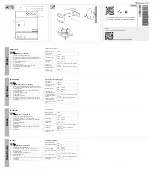
53
6.7.3
Motors with Long Starting Times
The usual approach is to select a starter with a larger
current rating, but this method, of course, involves a
degree of sacrifice of protection. Mitsubishi provides
a unique solution to this problem in the form of a satu-
rable reactor added to the OLR heater element. The
effect is to change the high-current characteristics,
so that nuisance tripping in starting is eliminated, with-
out loss of overload protection. Mitsubishi saturable
reactors are adjusted to allow around 25~30 seconds
of continuous starting current.
6.7.4 Motor Breakers (M Line MCCBs) and
Magnetic Contactors
M Line MCCBs are provided with trip curves espe-
cially suitable for motor protection, with ratings based
on motor full-load currents. They provide overcurrent
and short-circuit protection, and are normally used with
magnetic contactors. The need for protective coordi-
nation (as with a regular MCCB plus a starter) is elimi-
nated, and the reliability of protection in a short-cir-
cuit condition is far higher than that of the heater of a
starter OLR. Where the motor starting time is long,
the MCCB tripping curve must be checked carefully,
since tripping times are rather short in the delay-trip
range. Care must also be taken with respect to surge
conditions such as inching, reversing, restart, Y-delta
starting, etc.
6.7.5
Motor Thermal Characteristics
Overload currents in motors can lead to burnout, or
insulation damage resulting in shock or fire hazard;
the basic approaches to protection are (summarized
from Japanese standards):
1. MCCB + magnetic con OLR
2. Motor b magnetic contactor
3. Motor breaker alone
In 1, the OLR is the primary interrupter of overload,
and being adjustable, can be set for the true load re-
quirement. Large overcurrent or short-circuit fault con-
ditions are interrupted by the MCCB instantaneous
trip. In 2, the motor breaker is the protector for both
overload and short-circuit, and not being adjustable
must be selected carefully, for best coordination with
the load concerned. In 3, since the MCCB is relied on
not only for all protective functions but also for switch-
ing, this arrangement should be reserved for applica-
tions requiring infrequent motor starting and stopping.
6.7.6
Motor Starting Current
Motor starting times of up to 15 seconds are generally
considered safe; more than this is considered
undesirable; more than 30 seconds is considered
dangerous and should be avoided wherever possible.
For instantaneous tripping considerations, the MCCB
is normally set to 600% of the motor full-load current,
for trouble-free line-starting of an induction motor.
More detailed consideration is required where short-
time inrush effects (current magnification) are involved,
such as in Y-delta switching, running restart, etc. Two
basic causations are as follows:
1. Superimposed DC Transient (Low Power-Factor
Effect) Fig. 6.20 shows that the power factor is about
0.3 at starting, causing a significant DC component,
so that the total transient inrush current may reach
about twice the value of the AC component, even
though the latter is of constant amplitude. Peak in-
rush current (l
t
) of 1.4 x normal starting current (l
o
)
must be allowed for, in selecting the MCCB instanta-
neous-trip setting.
2. Residual Voltage (Running Restart)
If residual (regenerative) voltages appearing at the
motor terminals are out of phase with the supply volt-
age (at the time of reclosing after being interrupted,
before the motor speed is substantially reduced), the
cumulative effect of the line voltage and the residual
voltage is equivalent to the motor being directly sub-
jected to a large line overvoltage, with a resulting ab-
normal inrush current of:
Rsource V
Source V
✕
Normal starting inrush current
This is a current magnification effect, which may be
as much as 2 x in direct restarting, and
1+
3
1
(
)
x in Y-
delta-switching restarting. When the DC-transient fac-
tor (§1 above) is added, the magnification becomes
2.4 in the case of direct restarting, and 1.9 for Y-delta
restarting.
Fig. 6.21 Peak Inrush-Current Measurements
Fig. 6.20 Transient DC Component
1.8
1.7
1.6
1.5
1.4
1.3
1.2
1.1
I t
2
Io
It
0
Power factor (lag)
0.1 0.2 0.3 0.4 0.5 0.6 0.7
I o
Current magnification
34
32
30
28
26
24
22
20
18
16
14
12
10
8
6
4
2
0
0.2 0.4 0.75 1.5 2.2 3.7 5.5 7.5 22
30
Motor output (kW)
b) Test results
a) Test connections
Contactor
Backup
MCCB
CT
Motor
breaker
Oscillo-
graph
Direct (line) starting
Inching duty
Reversing duty
-delta switching
M










































